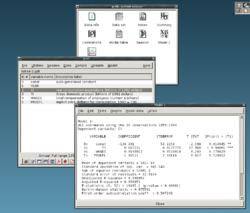Applications

Applied statistics, theoretical statistics and mathematical statisticsedit
Applied statistics comprises descriptive statistics and the application of inferential statistics. Theoretical statistics concerns the logical arguments underlying justification of approaches to statistical inference, as well as encompassing mathematical statistics. Mathematical statistics includes not only the manipulation of probability distributions necessary for deriving results related to methods of estimation and inference, but also various aspects of computational statistics and the design of experiments.
Statistical consultants can help organizations and companies that don't have in-house expertise relevant to their particular questions.
Machine learning and data miningedit
Machine learning models are statistical and probabilistic models that capture patterns in the data through use of computational algorithms.
Statistics in academiaedit
Statistics is applicable to a wide variety of academic disciplines, including natural and social sciences, government, and business. Business statistics applies statistical methods in econometrics, auditing and production and operations, including services improvement and marketing research. A study of two journals in tropical biology found that the 12 most frequent statistical tests are: Analysis of Variance (ANOVA), Chi-Square Test, Student’s T Test, Linear Regression, Pearson’s Correlation Coefficient, Mann-Whitney U Test, Kruskal-Wallis Test, Shannon’s Diversity Index, Tukey's Testdisambiguation needed, Cluster Analysis, Spearman’s Rank Correlation Test and Principal Component Analysis.
A typical statistics course covers descriptive statistics, probability, binomial and normal distributions, test of hypotheses and confidence intervals, linear regression, and correlation. Modern fundamental statistical courses for undergraduate students focus on correct test selection, results interpretation, and use of free statistics software.
Statistical computingedit
The rapid and sustained increases in computing power starting from the second half of the 20th century have had a substantial impact on the practice of statistical science. Early statistical models were almost always from the class of linear models, but powerful computers, coupled with suitable numerical algorithms, caused an increased interest in nonlinear models (such as neural networks) as well as the creation of new types, such as generalized linear models and multilevel models.
Increased computing power has also led to the growing popularity of computationally intensive methods based on resampling, such as permutation tests and the bootstrap, while techniques such as Gibbs sampling have made use of Bayesian models more feasible. The computer revolution has implications for the future of statistics with a new emphasis on "experimental" and "empirical" statistics. A large number of both general and special purpose statistical software are now available. Examples of available software capable of complex statistical computation include programs such as Mathematica, SAS, SPSS, and R.
Business statisticsedit
In business, "statistics" is a widely used management- and decision support tool. It is particularly applied in financial management, marketing management, and production, services and operations management . Statistics is also heavily used in management accounting and auditing. The discipline of Management Science formalizes the use of statistics, and other mathematics, in business. (Econometrics is the application of statistical methods to economic data in order to give empirical content to economic relationships.)
A typical "Business Statistics" course is intended for business majors, and covers descriptive statistics (collection, description, analysis, and summary of data), probability (typically the binomial and normal distributions), test of hypotheses and confidence intervals, linear regression, and correlation; (follow-on) courses may include forecasting, time series, decision trees, and other topics from business analytics more generally. See also Business mathematics § University level. Professional certification programs, such as the CFA, often include topics in statistics.
Statistics applied to mathematics or the artsedit
Traditionally, statistics was concerned with drawing inferences using a semi-standardized methodology that was "required learning" in most sciences.citation needed This tradition has changed with the use of statistics in non-inferential contexts. What was once considered a dry subject, taken in many fields as a degree-requirement, is now viewed enthusiastically.according to whom? Initially derided by some mathematical purists, it is now considered essential methodology in certain areas.
- In number theory, scatter plots of data generated by a distribution function may be transformed with familiar tools used in statistics to reveal underlying patterns, which may then lead to hypotheses.
- Methods of statistics including predictive methods in forecasting are combined with chaos theory and fractal geometry to create video works that are considered to have great beauty.citation needed
- The process art of Jackson Pollock relied on artistic experiments whereby underlying distributions in nature were artistically revealed.citation needed With the advent of computers, statistical methods were applied to formalize such distribution-driven natural processes to make and analyze moving video art.citation needed
- Methods of statistics may be used predicatively in performance art, as in a card trick based on a Markov process that only works some of the time, the occasion of which can be predicted using statistical methodology.
- Statistics can be used to predicatively create art, as in the statistical or stochastic music invented by Iannis Xenakis, where the music is performance-specific. Though this type of artistry does not always come out as expected, it does behave in ways that are predictable and tunable using statistics.
Comments
Post a Comment